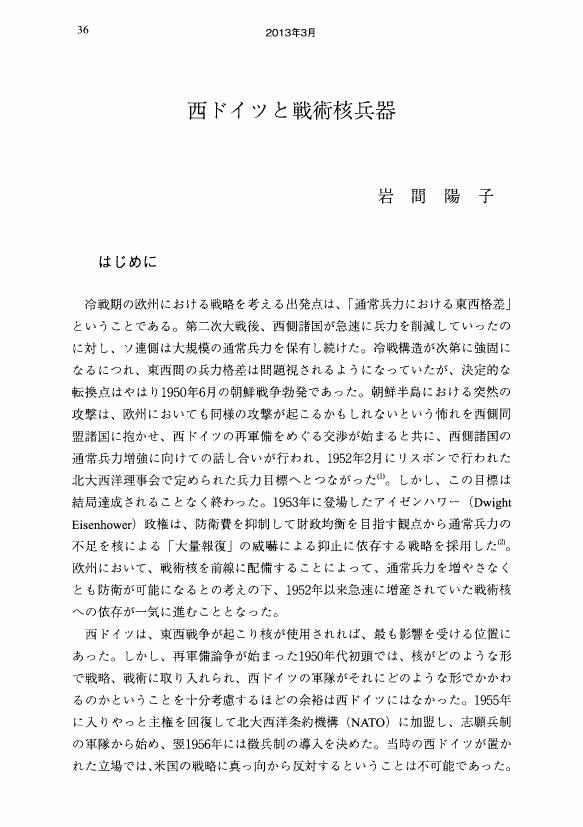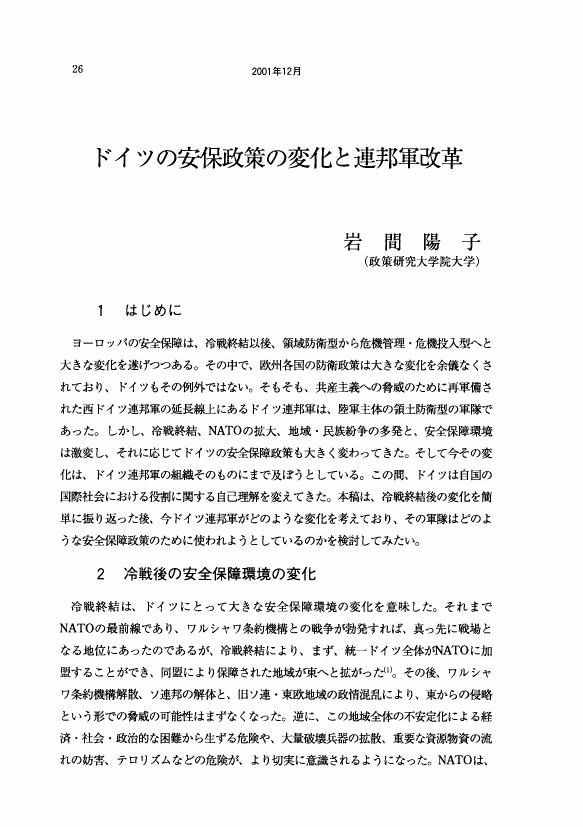8 0 0 0 OA アデナウアーと西ドイツの核保有問題
- 著者
- 岩間 陽子
- 出版者
- GRIPS Policy Research Center
- 雑誌
- GRIPS Discussion Papers
- 巻号頁・発行日
- vol.16-19, 2016-10
西ドイツ初代首相であり、1949年から1963年まで在任したコンラート・アデナウアーは、西ドイツの核保有を志向していたと言われるが、その実態はそれほど単純ではなかった。アデナウアーは、1954年のパリ協定署名時に、ABC(核・生物・化学)兵器の自国領内での製造を行わない宣言をしており、政権中にこの枠組みからはみ出すことはなかった。しかし、その範囲内で、西ドイツを核抑止の時代に適応させていった。まず、在独米軍の核兵器持ち込みを、事前協議制度なしで認めた。また、NATOの核備蓄制度を利用して、西ドイツ連邦軍の核搭載可能兵器を装備し、戦時には、それまで米軍管理下にある核兵器(弾頭)の配備を受ける制度を始めた。NATOの枠内での多角的核戦力(MLF)にも前向きな姿勢を見せながら、アデナウアーは何らかの形の「ヨーロッパ・オプション」に最後までこだわり続けた。それは、彼が米ソに大国のみが核を持つ世界では、ヨーロッパが見合うからの運命を決定する能力を失い、場合によっては超大国の取引対象となることを恐れたからであった。しかし、仏独エリゼー条約に対するアメリカの反応は、そのような道が非常に困難であることを示していた。Konrad Adenauer, the first West German Chancellor who was in office from 1949 to 1963, is said to have sought nuclear weapons for his country. But the truth is not that simple. Adenauer had renounced production of ABC weapons at the time of the signing of the Paris Treaties in 1954, and he never stepped out of this pledge. Instead, he adjusted his country to the nuclear age within that limit. First he allowed the American troops in West Germany to bring in nuclear weapons almost without any system of prior consultation. Next he put his country into the NATO nuclear stockpile system, by equipping the West German Bundeswehr with nuclear capable weapons. The nuclear weapons(warheads) to these weapons were usually under the control of American troops, and were passed onto the Bundeswehr at wartime. He also responded positively to the NATO multilateral force (MLF) plans, but also never ceased to look for an ‘European option.’ The reason for this was that he thought in a world in which only the US and USSR possessed nuclear weapons, Europe will no longer possess the ability to decide its own fate, and may become an object of deals between the two superpowers. But the American reaction to the Franco-German Elysée Treaty showed how difficult such an option was.
3 0 0 0 OA 西ドイツと戦術核兵器
- 著者
- 岩間 陽子
- 出版者
- 国際安全保障学会
- 雑誌
- 国際安全保障 (ISSN:13467573)
- 巻号頁・発行日
- vol.40, no.4, pp.36-53, 2013-03-31 (Released:2022-04-07)
2 0 0 0 OA 拡大するドイツ連邦軍の活動
- 著者
- 岩間 陽子
- 出版者
- 国際安全保障学会
- 雑誌
- 国際安全保障 (ISSN:13467573)
- 巻号頁・発行日
- vol.34, no.3, pp.119-134, 2006-12-31 (Released:2022-04-20)
1 0 0 0 OA ドイツの安保政策の変化と連邦軍改革
- 著者
- 岩間 陽子
- 出版者
- 国際安全保障学会
- 雑誌
- 国際安全保障 (ISSN:13467573)
- 巻号頁・発行日
- vol.29, no.3, pp.26-42, 2001-12-31 (Released:2022-04-28)
1 0 0 0 同盟と国家建設:―NATOとアフガニスタン―
- 著者
- 岩間 陽子
- 出版者
- JAPAN ASSOCIATION OF INTERNATIONAL RELATIONS
- 雑誌
- 国際政治 (ISSN:04542215)
- 巻号頁・発行日
- vol.2013, no.174, pp.174_125-174_138, 2013
The central role NATO played by ISAF (International Security Assistance Force) in Afghanistan was exceptional in its scope and intensity. The first steps of NATO into peacebuilding operations were in post Cold War Bosnia-Herzegovina and Kosovo. In these two cases, NATO remained in the role of keeping the secure environment and did not step in to the administrative and reformative roles. These were done mainly by the UN and EU.<br>NATO took up its role in Afghanistan, partly in order to save the alliance from its biggest crisis. Initially, ISAF's area of responsibility was limited to Kabul and its surroundings and its task was understood to be providing security. It soon had to take up reconstruction as local governments proved unable to provide basic services.<br>The Taliban reassembled itself within Pakistani northern territory and started to fight back from late 2005, causing severe damage. This led to the geographical and functional extension of ISAF operations. It expanded to cover the whole of Afghanistan in four stages, and its functions expanded. From the beginning,the PRTs (provincial reconstruction teams) contained inherent contradictions in that it brought together soldiers, diplomats and development specialists together, who had never before worked as a team. In many cases, soldiers and development specialists had different priorities and different time planning. The soldiers tended to opt for short term concrete projects which could "win the hearts and minds" of local people, whereas the development specialists preferred more long term sustainable projects which may not yield quick returns.<br>As the Tallibans regained control of southern Afghanistan, the security missions of ISAF started to include high-intensity fighting with insurgency. This led to a severe crisis of alliance relationships in that some countries were very reluctant to take up the fighting roles and even those who did, had to work under intense pressure of domestic politics in their home country. Canada and the Netherlands both tried to reconcile domestic politics and what it perceived to be alliance and international responsibilities. In the end they both had to bring back combat forces home earlier than the end of ISAF mission. What remained in the end for NATO were relatively low-intensity police and military personnel training mission.<br>The ISAF experience gives important lessons for future cases where international community will be asked to reconstruct states in the absence of general stability. We need to develop better insight into who can do which job best, and to respect each others' logic and make room for different actors.


